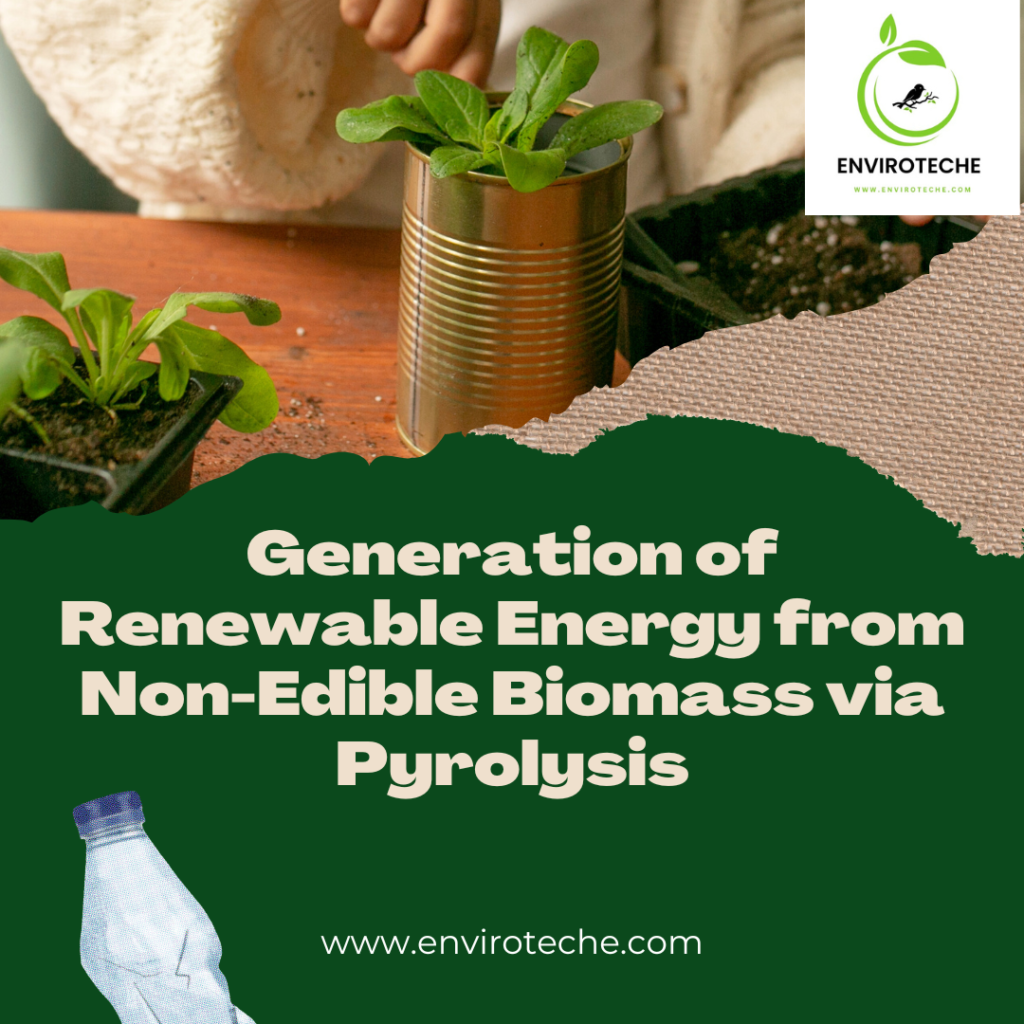Table of Contents

What is Biomass?
Biomass is a type of fuel made from organic waste left over from living things like plants, animals, forestry products, and human activity. The term “biomass” means the organic plant and animal matter that is used as a fuel and energy source (Field, Campbell, & Lobell, 2008). Biomass contains energy extracted from the sun as plants absorb the sun’s energy through photosynthesis. An typical home uses roughly 2325 kg of wood, 1480 kg of manure, or 1160 kg of crop leftovers per year, according to estimates. Biomass meets the world’s energy needs with modern forest management practices and a significant portion of energy through burning.
What are the types of biomass?
- Woody organic material
- Herbaceous organic material
- Animal and human organic material
- Biomass mixtures
What is Non-Edible Biomass?
Non-edible means not safe to eat or not designed for depletion. Depending on its source, non-edible organic matter has a different chemical constitution. Algae, in disparity to other organic compound, have a very high concentration of protein, lipid, and pigment. For instance, lignocellulosic is mostly made up of cellulose, hemicellulose, and lignin.
What is Renewable Energy?
The energy that we get from natural resources and which is produced faster than it is used is called renewable energy. Renewable energy comes from many sources. Its main sources are the sun and wind. We humans ourselves are included in it.
How does biomass function as a source of renewable energy?
The most important source of renewable energy is biomass, which we obtain by burning wood plants and other materials including manure and household waste. When it is burned, it produces large amounts of carbon dioxide, but this amount is still far less than the amount produced by burning fossil fuels (Drożyner, Rejmer, Starowicz, Klasa, & Skibniewska, 2013). If trees and plants are regularly planted and cared for, they absorb large amounts of carbon dioxide and release very little carbon. Compared to the amount produced by burning fossil fuels, substantially less carbon dioxide is released throughout the bioenergy process.
What is Pyrolysis?
When organic material, such biomass, is heated without oxygen present, the process is known as pyrolysis. It is a combination of the two words pyro and lysis, pyro meaning fire and lysis meaning breaking down into its components. During this process, organic molecules are heated to between 400 and 500 °C in the absence of oxygen. Fuels including charcoal, bio-oil, sustainable diesel, methane, and hydrogen are produced in the course of the pyrolysis.
Types of Pyrolysis
There are two types of Pyrolysis which are as follows
- Fast Pyrolysis
- Slow pyrolysis
Slow pyrolysis
Slow pyrolysis is a process we use to produce biochar in which various materials are subjected to thermal decomposition at a slow rate(∼10 °C/min).
Fast Pyrolysis
The most important pyrolysis process is fast pyrolysis, which typically yields 60 percent bio-oil and is completed very quickly in just a few seconds. In addition, 20% syngas and 20% charcoal are produced during this process (Armah et al., 2022). Some most important examples of fast Pyrolysis processes are Open-core fixed bed, ablative, cyclonic, and rotating core rapid pyrolysis systems.
Methods involved in the production of renewable energy from non-edible biomass
The various methods used for altering biomass into energy or biofuels can be graded as
- Direct combustion for the production of heat
- Thermo-chemical conversion for the production of solid, liquid, and gaseous fuels
- Biochemical conversion for the production of liquid fuels
1. Direct combustion
In the direct combustion process, first burned to produce hot gas in a device called a combustor. It is then pumped into a boiler to generate steam which is used for mechanical energy utilization. Direct combustion within the boiler produces temperatures between 800 and 1,000. Due to the essential requirement for the pretreatment, which includes scorching, chopping, and crushing it before bringing it into the combustion chamber, direct combustion has a slightly higher cost of energy production in contrast to pyrolysis and gasification.
2. Thermo-chemical conversion
The term “thermo-chemical conversion” describes the putrefaction of the organic components for the creation of solid, liquid, and gaseous biofuels. It falls into two categories:
- Dry procedures
Temperature rises during a dry thermochemical conversion process, biomass mostly faces structural degradation before undermining into condensable vapors and gaseous molecules.
- Hydrothermal technique
The process is also known as hydrothermal carbonization (HTC), and it produces essentially charcoal (a solid product) under mild circumstances (below 280°C, self-generated pressure).
3 Biochemical conversion
Through numerous processes, including anaerobic digestion, fermentation, and composting, the enzymes of bacteria and other microbes break down biomass in a process known as biochemical conversion.
Another method involved in the conversion of biomass into energy is gasification, which is explained below
Gasification
In the process of gasification, carbonaceous materials from fossil fuels are transformed into gases with high concentrations of nitrogen, carbon monoxide, hydrogen, and carbon dioxide. It is a method that turns straight into energy. The oxygen content is regulated and heated to a temperature of more than 700 °C in this process. When the molecules totally breakdown, syngas and slag are typically formed. Carbon monoxide and hydrogen are combined to form syngas.
What are the advantages of Biomass Energy?
The following are the main advantages of biomass energy
- As a major source of renewable energy, it has always been a uniquely accessible resource.
- It is free from carbon tracks.
- Its use has reduced the use of fossil fuels
- It is an excellent alternative to fossil fuels
- Biomass production has given its producers a great source of income
- This leads to less waste in landfills
What are the Disadvantages of Biomass Energy?
- Open burning of biomass has always been harmful to people as it releases large amounts of carbon dioxide into the atmosphere, which causes more respiratory diseases. Whereas waste produces less carbon dioxide in comparison to fossil fuels.
- The use of biomass in low-income areas poses serious risks due to lack of knowledge and proper procedures for the use
- Depending on the resources used, deforestation and land degradation can all be significant problems related to the production
Conclusion
In a nutshell, the potential usage of non-edible as an alternative to fossil fuels is an appealing approach to our search for sustainable energy production. This blog addresses several aspects of this technology, emphasizing its effectiveness in transforming into useful products like biofuels and biochar while reducing environmental effects. Until alternative sources of energy are found, it will play an important role in meeting energy shortage.
References
Armah, E. K., Chetty, M., Adedeji, J. A., Estrice, D. E., Mutsvene, B., Singh, N., & Tshemese, Z. (2022). Biochar: production, application and the future. In Biochar-productive technologies, properties and application: IntechOpen.
Drożyner, P., Rejmer, W., Starowicz, P., Klasa, A., & Skibniewska, K. A. (2013). Biomass as a renewable source of energy. Technical Sciences/University of Warmia and Mazury in Olsztyn(16 (3)), 211–220.
Field, C. B., Campbell, J. E., & Lobell, D. B. (2008). Biomass energy: the scale of the potential resource. Trends in ecology & evolution, 23(2), 65-72.
Check Other Scholarships:
- FREE Earth-inspired courses
- The Graduate Application Portal for King Fahd University, Saudi Arabia is open.
- International Excellence Scholarship 2023-24
- Scholarship in USA
Author detail:
Aisha Ghaffar1, Malayeka Khalid1
1Department of Chemistry, University Of Agriculture Faisalabad, Subcampus Toba Tek Singh
